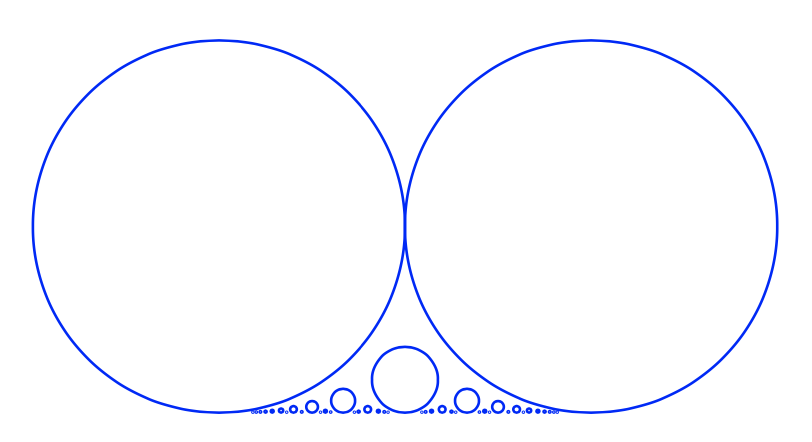Let me build on the idea of Steven Gubkin in his comments. One way to visualize this scenario is to use Ford circles. The standard picture is to plot a circle tangent to the $x$-axis at $\frac{p}{q}$ with radius $\frac{1}{2q^2}$ where we always assume $p$ and $q$ are relatively prime. This gives an intriguing family of circles with special tangency relationships. There is a crowd of circles with small radii just above the $x$-axis that can only be visualized in the mind's eye. These come from rational numbers with large denominators.
Think about this as an open covering of ${\bf Q}\cap [0,1]$: push each circle downwards, so that it is centered on the $x$-axis. The diameter of this depressed circle then marks an open interval of radius $\frac{1}{2q^2}$ centered at $\frac{p}{q}$.

An important visualization tool afforded by this: let $0<\alpha<1$ and draw a vertical line into the Ford circles emanating from the point $(\alpha,0)$ on the $x$-axis. Then every intersection of this vertical line with a Ford circle corresponds to a rational approximation $\frac{p}{q}$ of $\alpha$ satisfying $|\alpha-\frac{p}{q}|<\frac{1}{2q^2}$. Of course it is difficult to actually see most of these intersections because the vast majority of Ford circles have small radius and blend into the $x$-axis.
Dirichlet's approximation theorem states that for all irrational $\alpha$, there are infinitely many rational numbers such that $|\alpha-\frac{p}{q}|<\frac{1}{2q^2}$. In visual terms, the vertical line emanating from $\alpha$ interests infinitely many of the Ford circles. Stated in terms of the open covering of the rationals corresponding to the depressed Ford circles, each irrational $\alpha$ is in infinitely many of the open intervals. It is important to note that the "total length" of these intervals is infinite. There are $\phi(q)$ circles with radius $\frac{1}{2q^2}$ corresponding to rationals $\frac{1}{q}, \frac{2}{q},\cdots$.
Heuristically, $$\hbox{total length}=\sum_{\frac{p_i}{q_i}}\frac{1}{q_i^2}=\sum_{q_i}\frac{\phi(q_i)}{q_i ^2}\approx\sum_q \frac{1}{q}.$$
But now for the next step: let us shrink the radii of the Ford circles from $\frac{1}{2q^2}$ to $\frac{1}{2q^{2+\epsilon}}$. Here, for purposes of plotting, we will take $\epsilon=\frac12.$ So we will shrink radii to $\frac{1}{2q^{5/2}}$.
(In his comment, Steven Gubkin refers to $q^4$ instead of $q^\frac{5}{2}$. This of course works, but I found that the circles got too small to be an effective plot.)
Here is the corresponding visualization.

Notice that as soon as $\epsilon>0$, the beautiful tangency relationships between the Ford circles is lost. We still have an open covering of the rational numbers in $[0,1]$ by depressing these modified Ford circles. But one starts to "see," or least to anticipate, that something will change with the vertical lines and rational approximations to irrational numbers $\alpha$. Indeed, we have Roth's Theorem, which tells us that if $\alpha$ is an algebraic irrational number, then $\vert \alpha-\frac{p}{q}\vert<\frac{1}{q^{2+\epsilon}}$ has at most finitely many solutions. Thus for algebraic irrational numbers, we know that the vertical line will intersect at most finitely many modified (shrunken) Ford circles. In terms of the corresponding open covering of the rationals that we get by depressing the modified Ford circles, such $\alpha$ can be in at most finitely many of the open intervals. Also, we can see more by summing the lengths of the intervals:
$$\hbox{total length}=\sum_{\frac{p_i}{q_i}}\frac{1}{q_i^{\frac52}}=\sum_{q_i}\frac{\phi(q_i)}{q_i ^{\frac52}}<\sum_q \frac{q}{q^{\frac52}}=\sum_q \frac{1}{q^{\frac32}}<\infty.$$
In summary, by shrinking the radii of the Ford circles, we maintain an open covering of the rationals in the unit interval, but can control their radii so that the total length of this open cover is less than 1. It follows that there must be uncountably many vertical lines that do not intersect any modified Ford circle. In terms of the corresponding open cover of the rationals in the unit interval, there are uncountably many irrationals that are not in any of the subintervals.

